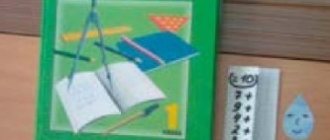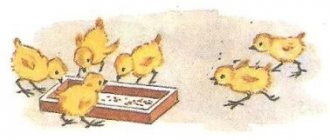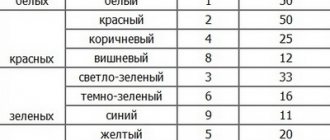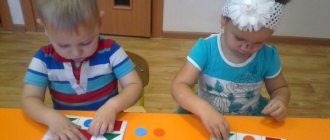Summary of an integrated lesson in mathematics “Problem Solving” for senior preschool age
Goal: to develop skills in solving arithmetic problems and performing arithmetic operations, adding and subtracting numbers within 10; promote increased cognitive interest with the help of information and computer technologies; foster positive reactions to success and the desire to achieve better results.
Software tasks:
Educational: teach children to analyze the conditions of a problem, highlighting essential and non-essential features; consolidate the ability to solve examples of addition and subtraction up to 10; learn to navigate on a sheet of paper, determine the direction from yourself; fix the names of geometric shapes.
Developmental: develop counting skills up to 10 forward and backward; develop graphic dictation skills; develop memory and attention; promote the development of independent and team work skills.
Educational: to cultivate a culture of communication among children, the ability to culturally defend their opinion; cultivate emotional responsiveness in children; sustainable interest in cognitive activity.
Wellness: help strengthen and maintain the physical and mental health of children; develop the skill of correct posture.
Integration with other areas:
Communication - contribute to the improvement of speech as a means of communication; consolidate the ability to draw conclusions and construct statements such as reasoning; continue to work on the clarity and volume of pronunciation of sounds.
Cognition - learn to assemble a craft according to an oral description, find new constructive solutions.
Socialization - continue to cultivate friendly relationships between children, the habit of playing together, working, and doing independently chosen activities; cultivate friendly relations with each other, the ability to work in groups.
Artistic creativity is to develop imagination, learn to add details that turn an evil animal into a good one.
Music - to give children an understanding of the nature of music using the sound of the sea, to develop an ear for music, to teach children to distinguish the sound and mood of the sea in a musical composition.
Progress of direct educational activities
1. Introduction of the game moment.
Educator
This morning a letter was brought to our kindergarten. Let's read it. “I am the most terrible pirate, Blackbeard, who hid his treasures on a desert island. It's not easy to get to. Difficult challenges await you along the way. You will have to show your knowledge, skills and intelligence. And only the bravest will be able to reach my treasures. Good luck!"
Are you ready to go on a treasure hunt?
Children: I agree.
2. Integration with design.
Educator:
In order to go on a journey we need to build ships. One ship will not be enough for us. Let's break into teams and build ourselves ships on which we will set sail. Each team has a construction kit in front of them, you must use all the parts.
(Children begin construction.)
Well done, they built good ships. Count how many parts you used?
(All teams have 10.)
And now it's time for us to set sail. We start counting down, from 10 to 0. The first team counts. Second. Third.
Well, here we are at sea. (Music is the sound of the sea.)
Waves splash around us, a light, warm, pleasant breeze blows. Guys, can you hear the sound of the sea? What kind of music is playing? (Calm, pleasant.)
3. Integration with speech development.
(The music continues to play.)
Oh, look, the ship ahead is aground. What does “running aground” mean?
(Children's answer options.)
Running aground means that the ship tried to sail where it was shallow and got caught in the sand with its bottom. The ship can't sail any further.
Educator:
The sailors from the ship are shouting something to us.
"Our ship ran aground,
And the sailors all week
Caramel stranded spruce"
Let's try to repeat what the sailors said. (First in chorus, then each team separately, individually at the request of the children.)
How long were the sailors stranded? — The sailors were stranded for a week.
How many days are there in a week? - 7 days a week.
What's the first day? — The first day of the week is Monday.
Etc.
How many working days and how many days off? — There are 5 working days and 2 days off.
Which days are more working days or weekends? — There are more working days.
4. Problem solving.
Let's help the ship refloat and take part of the cargo onto our ships. To do this, we need to solve problems.
- There were 10 barrels of caramel on the ship, the sailors ate 7. How many barrels were left?
How many barrels of caramel were on the ship? — There were 10 barrels.
How many barrels of caramel did you eat? - We ate 7 barrels of caramel.
What do you need to find in the problem? — How many barrels of caramel are left?
Place in front of you as many counting sticks as there were barrels of caramel. - Children lay out.
Look at everyone on your team having the same number of sticks.
Seven barrels of caramel were eaten. What need to do? - Remove, take away 7 sticks.
How many barrels of caramel are left? — 3 barrels of caramel left.
How many barrels of caramel do the second (third) team have left? — There are 3 barrels of caramel left.
- 5 dolphins swam near the ship, 2 more swam. How many dolphins are there?
How many dolphins swam? — 5 dolphins swam.
What happened next? — 2 more dolphins swam.
What do you need to learn in this task? - How many dolphins there are?
The dolphins have swam, what are we doing, adding or subtracting the counting sticks? - We need to add 2 sticks.
Solve this problem yourself, help a friend if he finds it difficult to solve it. I accept the answer only if the whole team has solved the problem.
Children work in groups.
- Sasha and Kolya fished and caught 6 fish,
The cat approached the fish, grabbed one and rushed off with it.
Guys, quickly count how many fish your friends have left.
Who is this problem talking about? — About the boys who fished.
How many fish did they catch? — They caught 6 fish.
Who snuck up on the boys? — A cat crept up to them.
How many fish did the cat grab? — The cat grabbed one fish.
What should be found in the problem? - How many fish are left?
The cat took the fish, do you need to add or subtract the counting sticks? - The cat took the fish, which means you need to take away the counting stick.
You also solve this problem in your teams and help each other if necessary.
- The first team took 4 boxes of soda, the second 3. How many boxes of soda did they take from the ship in total?
We solve the problem in the same way.
- There were 9 boxes of chocolate on the ship. You have eaten 8 boxes of chocolate. How many boxes of chocolate are left?
(Children solve problems using counting sticks according to commands and say the answer; in case of difficulty, the problem is sorted out at the board.)
5. Physical exercise
We have worked out very well, and now we will rest a little. Go out to the center of the group.
Here are cards with numbers from 1 to 10, you take them without looking. (The cards are upside down)
Stand in ascending order from 1 to 10.
And now in descending order from 10 to 1.
Children find their place on their own; if they make a mistake, the teacher helps correct it. Say out loud what your number is. Everyone agrees, did we stand up correctly? How should you stand up?
Educator:
Well done! You know how to count well, and now it’s time for us to continue our voyage to Treasure Island.
(The music of the storm-stricken sea sounds.)
Listen. How hard the waves began to beat against the side of the ship, how the wind strongly rocked our mast. What music is playing now? (Anxious, loud, restless.)
This sea monster is swimming towards us.
6. Graphic dictation.
Look, a monster is swimming from the island towards us. I can't see him well. Come on, I'll dictate, and you sketch it out box by box. And let's see if it's really scary. (Graphic dictation by cells - snake.)
The music turns off.
Place the leaves horizontally in front of you and put a dot in the corner of the cell on the left edge. The teacher shows where to put the point. Children perform graphic dictation independently.
Everyone draws only on their piece of paper, listens carefully to what I dictate.
I will repeat only 2 times, listen carefully. Whoever drew it, don’t shout, but put your hands on the desk, like schoolchildren. When everyone has drawn, I will dictate what to do next.
Oh, scary monster. Take colored pencils quickly and make him kind. (We turn on calm music. Children color their drawings and independently add details that make the monster kind.)
What cute animals you have created that don’t look like monsters at all. They will become your true friends and help you find treasures.
7. Geometric shapes.
Here we are on the island. Here is the treasure box. And it says on it that it is enchanted. “The treasure will be yours if you guess by touch what shape it is without looking.”
Who is the bravest? Who isn't afraid to put their hand into an enchanted box?
(Children, accompanied by calm music, take out geometric shapes by touch, naming them. If they named them correctly, they take the treasure for themselves; if they made a mistake, then put it back in the bag and try again after other children.)
8. Conclusion.
Our journey has now ended.
Raise your hands who liked it.
Where have we been today?
What was interesting during the lesson, what did you like?
What was the most difficult thing about this journey?








